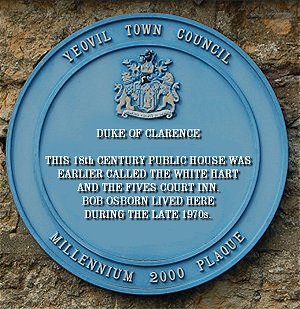the history of yeovil's pubs
PUBS HOME PAGE |
PUBS INTRODUCTION |
PUBS BY NAME |
BEERHOUSES |
duke of clarence
5 Stars Lane
 The
early history of
the Duke of
Clarence, in
Stars Lane
and shown pink
on the map at
left, is
something of a
mystery.
Certainly the
inn was once
known as the
Fives Court Inn
due to the
presence of a
fives court at
the rear of the
premises. The
date of this is
unknown but is
likely to have
been during the
18th century,
albeit not in
the current
building.
The
early history of
the Duke of
Clarence, in
Stars Lane
and shown pink
on the map at
left, is
something of a
mystery.
Certainly the
inn was once
known as the
Fives Court Inn
due to the
presence of a
fives court at
the rear of the
premises. The
date of this is
unknown but is
likely to have
been during the
18th century,
albeit not in
the current
building.
Fives is a British sport believed to derive from the same origins as many racquet sports. In fives, a ball is propelled against the walls of a special court using gloved or bare hands as though they were a racquet. Although the etymology of "fives" is still obscure, it is generally accepted that the word means the fingers of the hand acting in unison as in a "bunch of fives".
The word was not used before the 17th century, but long before that the game was being played. Although now mainly associated with public schools, fives historically was often played between the buttresses of churches and many records exist in south Somerset of church towers being used. Also there survive several fives walls in the area where the game was very popular, especially in the 18th century. At one time a fives court stood in Huish Field, certainly in 1835 when part of the field was sold.
After being known as the Fives Court Inn for many years, by 1790 it was known as the White Hart until the mid-1860's when it assumed the name Duke of Clarence.
From 1828 until at least 1846 the White Hart was owned by Thomas Cave, the Yeovil brewer and maltster of Hendford (today's Princes Street), later to become partner with Joseph Brutton.
In September 1862 Mr Harris, a builder, applied for a transfer of the license to the Borough Petty Sessions. Superintendent Smith of the police said of the White Hart "this was the worst hole in the town, and it was a piece of a house after all." The license transfer was refused but Mr Harris replied that he was going to build a new house, so we must assume that the present building, and also the name change to the Duke of Clarence, dates from this time.
However, even as late as 1884 it was noted in the Western Gazette's edition of 5 September, in reporting the proceedings of the Borough Petty Sessions "Little mishaps occurred no and again at the Buck Inn. On one occasion, a barrel of porter was stolen from the house and carried to the top of Summerhouse Hill, where it was drunk."
It was renamed the Duke of Clarence in honour of Prince Albert Victor, Duke of Clarence and Avondale (1864 -1892), the eldest child of the Prince and Princess of Wales (later King Edward VII and Queen Alexandra) and grandson of the reigning British monarch, Queen Victoria. From the time of his birth, he was second in the line of succession to the British throne, but never became king: he died before his father and his grandmother, the Queen.
An indenture (re-conveyance) in my collection, suggests that the Duke of Clarence was owned by brewer Edmund Charles Henning and John Blake Sully during the 1880s and mortgaged by Samuel Hitchcock.
Tony Robins recalled that his father, Harold, called the Duke of Clarence the "Young Buck" which must have been a hangover from the days the pub was called the White Hart.
|
Yeovilians remember... From me - "The Duke of Clarence closed in 1965 and a Chinese takeaway and a Taxi company occupied the ground floor and new shop fronts were added. In 1979 the Duke of Clarence had its greatest honour to date, when I lived in the first floor corner flat for a year or two. From memory the building reopened as Licensed premises during the late 1990's as an American themed bar simply called Stars Lane (thanks to Tristan Cobb for reminding me), later renamed as Harry's Bar, which then closed and re-opened as Bar 45 and given a bright blue (and somewhat out of character) exterior paint job. Fortunately this incarnation didn't last long and the building received a less harsh paint-job. It is currently (2017) called Karma Bar" |
![]()
Of the early licensees, George Raymond was born about 1794 at Queen Camel, seven miles northeast of Yeovil. George was listed as licensee of the White Hart in 1828 and 1830 which, at the time, was owned by Thomas Cave the brewer of Hendford. George was also listed as a shopkeeper and bacon and cheese factor. Interestingly in the 1840 Somerset Gazette Directory he is also listed as a brewer making him one of only two or three beerhouse keepers actually known to have taken advantage of the brewing part of the Beerhouse Act 1830. Or was he? The 1841 census also lists him as a brewer, living in the same house in Hendford as the commercial brewer Edmund Henning. It may be, therefore, that George Raymond was running what would effectively have been the brewery tap for Henning's brewery. In 1841 George was living with his wife, Mary, and their 14-year old son, George. By 1851 Henning had gone and George gave his occupation as inn keeper and his son George was listed as his assistant. By 1861 George and Mary were living in South Street where George, now aged 66, gave his occupation as cheese dealer etc. By 1871 George and Mary were living in Thomas' Yard off Kingston where George described his occupation as dealer in cheese, malt & hops. By 1881 George had finally retired and, somewhat surprisingly, gave his occupation as retired publican. He and Mary were still living in Kingston but Mary died in the summer of 1881 and George died in the summer of 1883.
William Trahern was noted in Robson's Directory of 1839 but was presumably too ill to continue running the White Horse and his wife, Nancy, was listed as licensee in the 1840 Somerset Gazette Directory. William died in early 1843 but I could find no further reference to Nancy.
There is little mention of John Kase in the records other than in the 1841 census when he appears as licensee of the White Hart Inn, aged 32 and born in Somerset. There was no wife present, but two sons aged 12 and 4. I couldn't find any further references. A Sarah Case died in Yeovil in 1838 but that may be a coincidence and there is nothing to link her to John.
Similarly John Slade is only mentioned once as the White Hart's licensee, in Pigot's Directory of 1842. In the 1841 and 1851 censuses in Yeovil he is a solicitor living on Penn Hill, South Street, so once again there is no further information on 'our' John Slade. As for John Westover, mentioned as licensee in Slater's Directory of 1842, I could find no further information at all.
There was little more information forthcoming on the next licensee, Robert Bowditch. He was born around 1824 at Beaminster, Dorset, one of the extensive Bowditch family from the area. In the 1861 census he was listed as the innkeeper of the White Hart Inn with his wife, Mary. In 1861 Robert Bowditch was found guilty by the magistrates for selling beer during prohibited hours and was fined ten shillings and costs. This was the last time the White Hart was referred to as such and from now on would be known as the Duke of Clarence. By 1871 Robert and Mary were living in Broadwindsor, Dorset.
John Bunn was mentioned just the once, in Kelly's Directory of 1866. I couldn't find any further information either before or after this date primarily due to an excess of John Bunns at this time.
William Thorne was granted a license for the Duke of Clarence in September 1869. In its edition of 9 September 1870 however, the Western Gazette in reporting the Borough Petty Sessions noted "The beerhouse certificate of the Duke of Clarence, kept by a man named Thorn, was refused, on the ground that the applicant's wife had withheld information relating to the purchase of some stolen goods in May last."
George Lugg was born around 1819 in Yeovil. In 1841 George was an assistant turnkey at Ilchester County Gaol, one of nine members of staff. At this time there were additionally nine members of staff's family, 26 debtors and 52 criminal prisoners plus two infants with their mothers in the gaol. In the 1875 Post Office Directory George is listed as licensee of the Duke of Clarence and in the 1881 census, at the age of 62, he is listed as an innkeeper with his wife, Maria, and young son Charles. Their daughter, Eliza, aged 30 and a widow, was employed as a barmaid. Additionally there were seven lodgers and boarders. After 1881 the Luggs seem to disappear from the records.
John Guppy, by trade a tailor, was born around 1848 in Hardington Mandeville. In 1881 he was living at 10 Stars Lane with his wife, Elizabeth of South Perrott, Dorset, and their five children including their 5-month old son named Bollar Guppy. By 1895 John was listed as a Beer Retailer in Kelly’s Directory and was also listed in Whitby's Yeovil Almanack Advertiser of 1899, but by the following year the family had moved on.
The next four licensees all made just single appearances in the records but in 1911 William Miles took over the license and between them, he and his wife Ada were to run the Duke of Clarence for more than the next forty years.
William Henry Miles was born on 19 February 1871 in Brean, north Somerset. He enlisted in the Somerset Light Infantry in 1888 and served for 21 years, retiring as a Colour Sergeant in 1909. He served in the Boer War and was mentioned in the dispatches of Lord Kitchener with a commendation for the operations in Eastern Transvaal “For conspicuous gallantry and good service during Boer attack on a convoy near Mooifontein, south of Bethel, on 25 May 1901”. His final posting in 1909 was as a Permanent Staff Instructor to the Territorial Army residing at the TA’s Armoury House in Park Road. William's wife, Ada Louisa, was born in 1879 in Aldershot, Hampshire. In the 1911 census William is recorded as an army pensioner, so there are no prizes for guessing where he met Ada. They had married when Ada was just 19 and, being an army family, had moved around during William's army career with children born in Portland, Dorset, Camden Town, London, three in Taunton (the last of these in 1908) and their baby in Yeovil indicating that William spent his last few years of service at Taunton's Jellalabad Barracks before retiring from the army to live in Yeovil around 1909. then became the inn keeper of the Duke of Clarence Inn until his death in 1938. On William’s death, his widow Ada Louisa (b1879) became the Inn Keeper until her death on 24 December 1949. Ada was from a military family, had a brother who was a Lt. Colonel in the Royal Marines and a son who was a Lt. Colonel In the Indian Army Ordnance Corps. Ada’s early life was in Guernsey and Alderney where her father served as a soldier. She was assisted in running the Duke of Clarence by her sister Martha (1886-1968) who had been widowed during the First World War.
gallery

A 1928 aerial view of Stars Lane with the Duke of Clarence (slightly masked, but seen as two separate buildings at centre).To the left of the Duke of Clarence and running to the top left of the photo are seen the houses in Duke of Clarence Yard. To the right the large building is the old Palace Theatre - Yeovil's first cinema - on the corner of Stars Lane and South Street. At extreme right is the Triangle. Note also the large gas holder at bottom left.
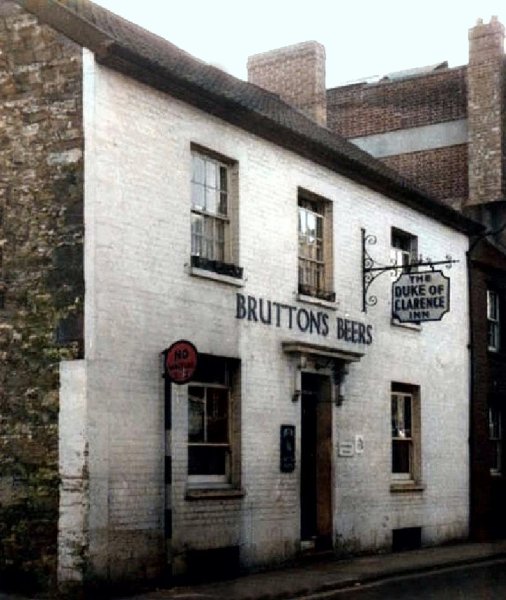
A colourised photograph of 1960, by Charrington & Co Ltd's surveyors as part of a 'stocktaking' exercise of photographing Brutton's pubs prior to the brewery takeover.
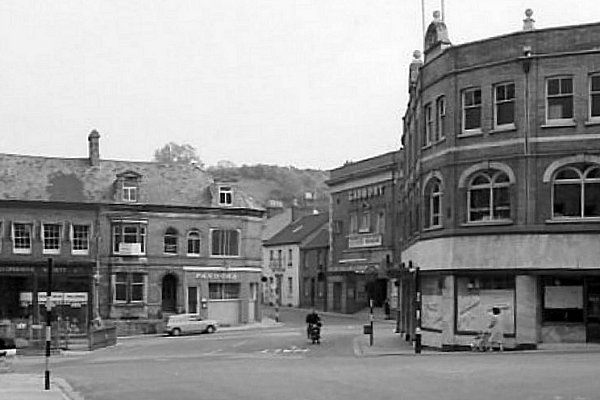
This 1960's photograph of the Triangle shows the Duke of Clarence in Stars Lane, the white building at the very centre of the photograph, before it had acquired the small house between it and the Gaumont cinema. Also seen in the photograph are buildings that would later become Woods Wine Bar (sandwiched between the Co-operative Society shop at left and the Pandora coffee bar on the corner of Stars Lane) and Porter Blacks (the old Co-operative Society building dominating the right hand side of the photograph).
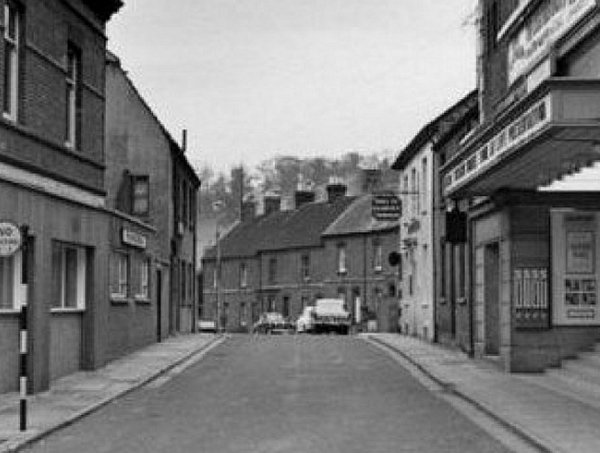
The top of Stars Lane photographed in the 1960's. The Duke of Clarence is the white building at right, a door or two down from the Gaumont Cinema, successor to the Palace Theatre that, in turn, replaced more original cottages.
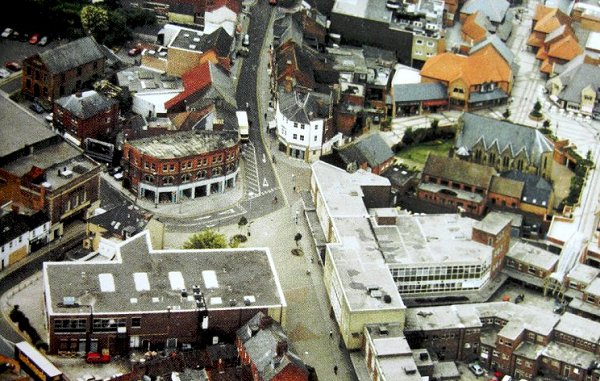
This aerial photograph of the Triangle dates to 1988. The Duke of Clarence is the white building at centre left. The left half of the large building at bottom left is now Modello while the old Porter Black building, originally the Co-op offices, stands left of centre facing the Triangle with the start of South Street to its left and Middle Street, running from top centre to bottom centre, to its right. At top right is the recently-constructed Quedam shopping centre.
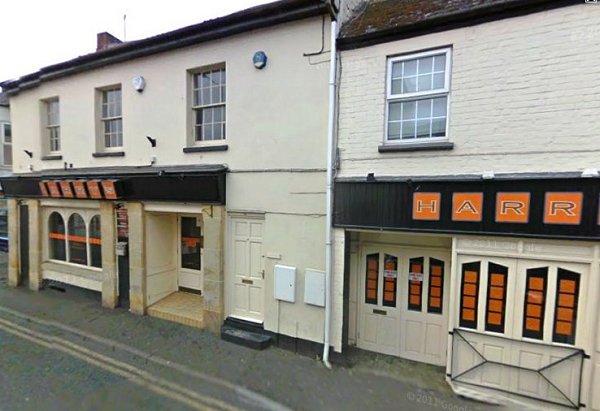
Photographed in 2009, Harry's Bar occupied not just the old Duke of Clarence building but the adjacent properties as well.
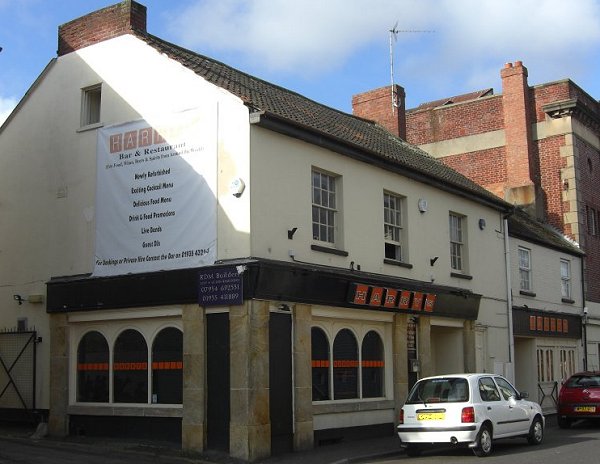
Where the left-hand two windows at first floor are was my flat in the late 1970's.
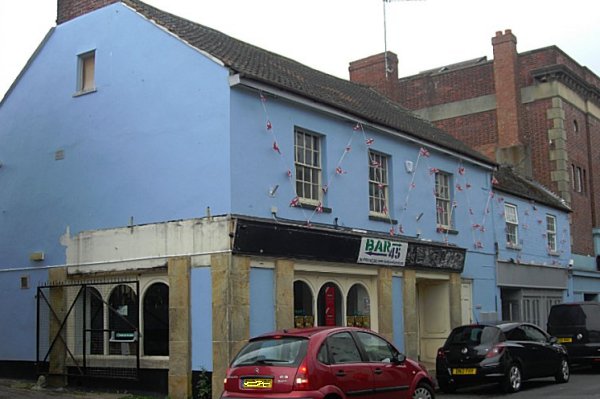
Photographed in 2012, Harry's Bar has gone and now it is Bar 45 (with a somewhat garish and unsympathetic paint job).
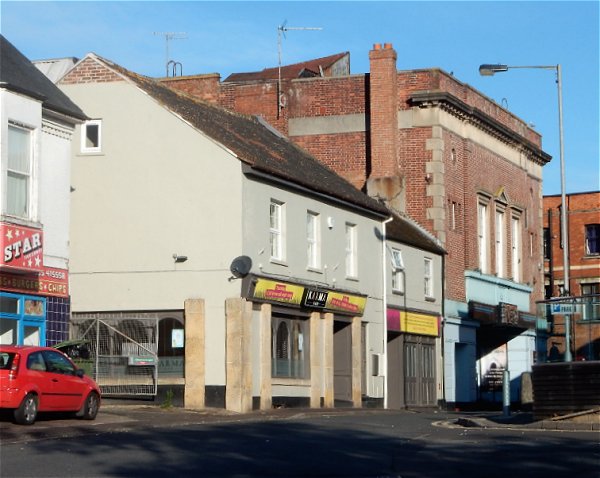
Changed hands yet again - it's presently the Karma Bar. At least the new paint job isn't in the same league of cheap and tacky as its previous colour scheme. Photographed in 2016.
. . . . and finally
|
|
Please don't go looking for this one just yet as it's not there. Yeovil Town Council please note - this is the design for the plaque that should be mounted on the old Duke of Clarence pub in Stars Lane. Yes, I know I only lived there for two years but Mr T Hardy only lived in Peter Street for a few months and he got a plaque. Thanks
in
advance
|
owners / occupiers / licensees
as the
White Hart Inn
1790 – Mrs
Loveridge –
Victualler (1790
Universal
British
Directory)
listed as White
Hart
1822 – John
Severidge
(Pigot’s 1822
Directory)
listed as White
Hart
1824 – John
Severidge
(Pigot's 1824
Directory)
listed as White
Hart, Stars Lane
1828 – Geo.
Raymond, from T
Cave (Land Tax
Return - SRO
Q/RE1)
1830 – George
Raymond (Pigot’s
1830 Directory)
listed as White
Hart
1830 – Thomas
Cave, owner -
George Raymond,
occupier (Land
Tax Return - SRO
Q/RE1)
1835 – Licensee
not named
(Robson's 1835
Somerset
Directory)
1839 – William
Trahern
(Robson’s 1839
Directory)
listed as White
Hart
1840 – Nancy
Trahern (1840
Somerset Gazette
Directory)
listed as White
Hart, South
Street (sic)
1841 – John Kase
– Inn Keeper
(1841 census)
listed as White
Hart Inn
1842 – John
Slade (Pigot’s
1842-4
Directory)
listed as White
Hart
1846 – Thomas
Cave, Owner –
Alfred Slade,
Occupier (1846
Tithe
Apportionment)
1850 – John
Denning (Hunt &
Co 1850
Directory)
listed as White
Hart
1852 – John
Westover – Inn
Keeper (Slater’s
1852 Directory)
listed as the
White Hart
1860 – Robert
Bowditch
– Spirit license
refused (Petty
Sessions)
1861 – Robert
Bowditch – Inn
Keeper (1861
census) listed
as White Hart
Inn
1862 – Mr
Harris, builder
– refused
transfer of
license (Borough
Petty Sessions)
as the
Duke of Clarence
1866 – John Bunn
jnr. (Kelly’s
1866 Directory)
listed as Duke
of Clarence,
Stars Lane
1867 – Thomas
Dodd -
Fined for
refusing to
admit police
(Petty
Sessions,
December)
1869 – William Thorn -
License granted
(Borough Petty
Sessions,
October)
1870 – Mr Thorn -
License refused (Borough
Petty Sessions) as Duke of
Clarence
1871 – George
Horsey -
Plasterer (1871
census) listed
as Duke of
Clarence
1872 – George
Horsey – Beer
Retailer
(Kelly's 1872
Directory)
1875 – George
Lugg – Beer
Retailer (1875
Post Office
Directory)
1875 – George
Lugg – Beer
Retailer
(Kelly's 1875
Directory)
1881 – George
Lugg – Innkeeper
(1881 census)
listed as Duke
of Clarence
1882 – John
Henry Norman ??
(Whitby's 1882
Yeovil Almanack
Advertiser)
1884 – George
Lugg - assaulted
by John Penny
(Borough Petty
Sessions,
January)
1887 – George
Lugg – license
transfer (Petty
Sessions, May)
1887 – John
Guppy – license
transferred (Petty
Sessions, May)
1891 – Family of
John Guppy, a
Tailor, in
residence only
(1891 census)
1895 – John
Guppy – fined
for after hours
sessions (Petty
Sessions)
1895 – John
Guppy – Beer
Retailer
(Kelly’s 1895
Directory) pub
not named
1897 – John
Guppy – Beer
Retailer
(Kelly’s 1897
Directory)
1899 – John
Guppy (Whitby's
1899 Yeovil
Almanack
Advertiser)
listed as Duke
of Clarence Inn
1900 – John
Partridge
(Whitby's 1900
Yeovil Almanack
Advertiser)
1901 – Edward
Jee – Publican
(1901 census)
pub not named
1907 – T Norris
(1907 Yeovil
Directory)
listed as Duke
of Clarence,
Summerhouse Road
1911 – Mr Bell
(Lodger) (1911
census Summary)
pub listed but
not named
1911 – WH Miles
(Whitby's 1911
Yeovil Almanack
Advertiser)
listed as Duke
of Clarence Inn
1914 – William
Miles – Beer
Retailer
(Kelly’s 1914
Directory) pub
not named
1918 – WH Miles
(Whitby's 1918
Yeovil Almanack
Advertiser)
listed as Duke
of Clarence Inn
1923 – William
Miles – Beer
Retailer
(Kelly’s 1923
Directory) pub
not named
1936 – WH Miles
(1936 Yeovil
Directory)
listed as Duke
of Clarence
1938 – WH Miles
(1938 Yeovil
Directory)
listed as Duke
of Clarence
1939 – Ada Miles
(Kelly’s 1939
Directory)
listed as Duke
of Clarence Inn
1947 – WH Miles
(1947 Yeovil
Directory)
listed as Duke
of Clarence
1949 – AL Miles
(Kelly’s 1949
Directory)
listed as Duke
of Clarence
1951 – AL Miles
(1951 Yeovil
Directory)
listed as Duke
of Clarence
1954 – AL Miles
(1954 Yeovil
Directory)
listed as Duke
of Clarence
1957 – W Gough
(1957 Yeovil
Directory)
listed as Duke
of Clarence
1960 – WG Gough
1965 – Licensee
not named (1965
Yeovil
Directory)
listed as Duke
of Clarence
1968 – Licensee
not named
(Kelly’s 1968
Directory)
listed as Duke
of Clarence
(although it
closed in 1965).
as Bar
45
2012 – Jordan
Frost - didn't
last long -
that'll teach
him not to paint
buildings bright
blue!!!
